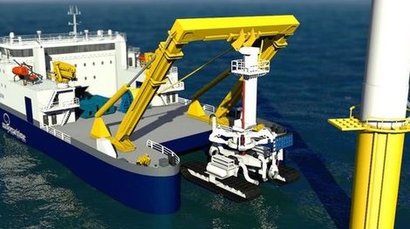
The two companies have secured an EU Horizon 2020 Grant to support the 1,200,000 euro project which will develop an ROV for use in high energy tidal sites and will be capable of being operated from Mojo’s tidal energy vessel, the Hi Flo 4 (HF4).
Array installation accounts for a significant proportion of overall tidal energy costs. To address this issue, Mojo Maritime designed and developed the HF4 between 2012 and 2014. The HF4 is an offshore construction vessel (OCV) capable of lifting the heaviest envisaged tidal turbines and of dynamically positioning in up to 5.0 ms-1 (10 knots) of tidal stream.
The operational advantages of HF4 will feed through into installation benefits and Mojo’s early analysis, using the Mermaid (Marine Economic Risk Management Aid) operations planning software tool, shows that in medium energy tidal sites HF4 can install tidal arrays in half the time and at a third of the cost of conventional methods. The vessel therefore offers the possibility of levelised costs of energy for tidal arrays of £118 per MWh, which is already below that of many envisaged offshore wind projects. Mojo is now working with its ship-owning partner, Hammonia Reedeira, to select a yard to build the first-of-class HF4, with an anticipated delivery date target of late 2016.
The next step in reducing costs is to improve the performance of key installation tools, such as ROVs, which are used not only for turbine and foundation installation, but also for cable touch-down monitoring. Conventional ROVs are generally designed to operate in subsurface currents of up to 1.5 ms-1 but Mojo has found that many of them struggle above 1.0 ms-1. This means that they are a key operating limitation in the design (and cost) of the marine operations for tidal energy installations, where subsurface current speeds of 5.0 ms-1, are the norm in high energy tidal sites.
For this reason, Mojo and IKM joined forces in mid-2014 to bid for EU funding, from the Maritime Technologies (MARTEC II) call, to develop a HF ROV capable of being operated from the HF4 in high energy tidal sites. The companies will aim to develop a basic design for an HF ROV that is capable of then being manufactured according to a schedule that will align with the envisaged build schedule for the HF4 ship. Given that it was designed primarily for the tidal energy sector, the HF4 vessel is highly optimised and therefore offers cost effective performance which can be applied to a wide range of operations, including offshore wind and oil and gas. The HF ROV is anticipated to be able to operate from both HF4 and OCV’s in a range of offshore operations and conditions.
Mojo’s extensive tidal technology installation background will complement IKM’s ROV manufacture and operations experience, which includes the design, build and operation of modern WROVs, such as IKM’s Merlin WR200, which was designed to be the most efficient and reliable work class ROV on the market.
Work on the project began on 5th January 2015 and will continue through to the end of the year.
For additional information:

